Raleigh, North Carolina, Hgh State Clinic, Hgh Injections, Hrt Doctors
Raleigh, North Carolina Blood Testing Facilities
 Represents a LabCorp blood testing facility
Represents a LabCorp blood testing facility Represents a Quest Diagnostics blood testing facility
Represents a Quest Diagnostics blood testing facility
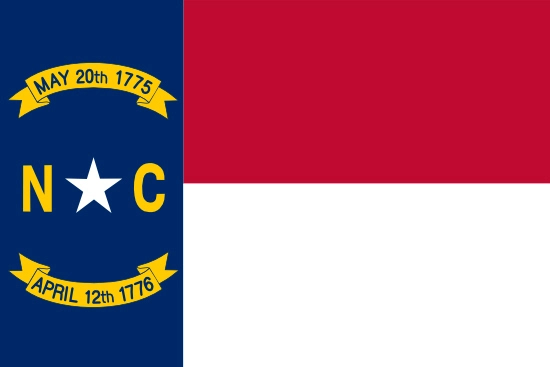
Nearby Labcorp Blood Testing facilities:
- Labcorp Center Distance: 3 m, 4009 Barrett Dr Ste 104, Raleigh, Wake County, NC, 27609
- Labcorp Center Distance: 4 m, 3200 Blue Ridge Road Ste 200, Raleigh, Wake County, NC, 27607
- Labcorp Center Distance: 6 m, 6729 Falls Of Neuse Rd Ste 102, Raleigh, Wake County, NC, 27615
- Labcorp Center Distance: 7 m, 1110 Se Cary Pkwy Ste 205, Cary, Wake County, NC, 27518
- Labcorp Center Distance: 8 m, 8300 Health Park Suite 223, Raleigh, Wake County, NC, 27615
- Labcorp Center Distance: 9 m, 11001 Durant Road Ste 106, Raleigh, Wake County, NC, 27614
- Labcorp Center Distance: 12 m, 10831 Forest Pines Dr Ste 108, Raleigh, Wake County, NC, 27614
- Labcorp Center Distance: 13 m, 104 Bass Lake Road Suite 100, Holly Springs, Wake County, NC, 27540
- Labcorp Center Distance: 15 m, 2945 South Miami Blvd 132, Durham, Durham County, NC, 27703
- Labcorp Center Distance: 23 m, 5324 Mcfarland Drive Ste 100, Durham, Durham County, NC, 27707
- Labcorp Center Distance: 24 m, 328 N Brightleaf Blvd, Smithfield, Johnston County, NC, 27577
- Labcorp Center Distance: 26 m, 100 Timberhill Place Suite 122, Chapel Hill, Orange County, NC, 27514
- Labcorp Center Distance: 27 m, 100 South 10Th Street, Lillington, Harnett County, NC, 27546
- Labcorp Center Distance: 37 m, 1133 Carthage Street Unit De, Sanford, Lee County, NC, 27330
- Labcorp Center Distance: 38 m, 2402 Camden Street Ste 600, Wilson, Wilson County, NC, 27893
- Labcorp Center Distance: 39 m, 3302 Nash Street North, Wilson, Wilson County, NC, 27893
- Labcorp Center Distance: 40 m, 3940 Arrowhead Blvd Ste 240, Mebane, Alamance County, NC, 27302
- Labcorp Center Distance: 45 m, 107 Weeks Drive, Roxboro, Person County, NC, 27573
- Labcorp Center Distance: 46 m, 2400 Wayne Memorial Dr. Ste E, Goldsboro, Wayne County, NC, 27534
- Labcorp Center Distance: 50 m, 855 Heather Rd, Burlington, Alamance County, NC, 27215
- Labcorp Center Distance: 51 m, 1041 Kirkpatrick Rd, Burlington, Alamance County, NC, 27215
- Labcorp Center Distance: 53 m, 105 Roxie Ave, Fayetteville, Cumberland County, NC, 28304
- Labcorp Center Distance: 60 m, 8 Regional Circle, Pinehurst, Moore County, NC, 28374
- Labcorp Center Distance: 65 m, 610 N Fayetteville St. Ste 110, Asheboro, Randolph County, NC, 27203
- Labcorp Center Distance: 67 m, 1126 N Church St Ste 104, Greensboro, Guilford County, NC, 27401
- Labcorp Center Distance: 68 m, 2111B N Queen St, Kinston, Lenoir County, NC, 28501
- Labcorp Center Distance: 69 m, 520 Maple Ave Ste A, Reidsville, Rockingham County, NC, 27320
- Labcorp Center Distance: 70 m, 1818 Richardson Drive Ste C, Reidsville, Rockingham County, NC, 27320
- Labcorp Center Distance: 71 m, 174 Executive Drive Ste C, Danville, Other, VA, 24541
- Labcorp Center Distance: 72 m, 202 E. Ferrell Street, South Hill, Mecklenburg County, VA, 23970
- Labcorp Center Distance: 76 m, 3610 Peters Court Suite 200, High Point, Guilford County, NC, 27265
- Labcorp Center Distance: 82 m, 137 Mt. Calvary Road Suite B, Thomasville, Davidson County, NC, 27360
- Labcorp Center Distance: 83 m, 445 Pineview Dr Ste 210, Kernersville, Forsyth County, NC, 27284
- Labcorp Center Distance: 94 m, 2932 Lyndhurst Ave, Winston Salem, Forsyth County, NC, 27103
- Labcorp Center Distance: 95 m, 3333 Brookview Hills Ste 103, Winston Salem, Forsyth County, NC, 27103
- Labcorp Center Distance: 99 m, 7 Office Park Drive Suite 2, Jacksonville, Onslow County, NC, 28546
Nearby Quest Blood Testing facilities:
- Quest Center Distance: 2 m, 3031 New Bern Ave, Raleigh, Wake County, NC, 27610-2989
- Quest Center Distance: 8 m, 103 Baines Court, Cary, Wake County, NC, 27511-6646
- Quest Center Distance: 15 m, 1014 Procure St., Fuquay Varina, Wake County, NC, 27526-2620
- Quest Center Distance: 25 m, 3333 Nc Highway 242 N, Benson, Johnston County, NC, 27504-7844
- Quest Center Distance: 38 m, 2605 Forest Hills Rd, Wilson, Wilson County, NC, 27893-4448
- Quest Center Distance: 39 m, 381 Ruin Creek Rd, Henderson, Vance County, NC, 27536-2932
- Quest Center Distance: 46 m, 2400 Wayne Memorial Dr, Goldsboro, Wayne County, NC, 27534-1750
- Quest Center Distance: 54 m, 1840 Owen Dr, Fayetteville, Cumberland County, NC, 28304-3455
- Quest Center Distance: 67 m, 1002 N Church St, Greensboro, Guilford County, NC, 27401-1448
- Quest Center Distance: 70 m, 2070 West Arlington Blvd, Greenville, Pitt County, NC, 27834-3769
- Quest Center Distance: 95 m, 200 Charlois Blvd, Winston Salem, Forsyth County, NC, 27103-1536
- Quest Center Distance: 99 m, 200 Doctors Dr, Jacksonville, Onslow County, NC, 28546-6308
Raleigh Hormone Replacement Therapy Services
Here at the Conscious Evolution Institute, we understand that Hormones are a major part of what makes you, you. Achieving Hormone Balance is an important aspect of achieving peak wellness and living a life teeming with vitality. We are a licensed and board-certified Hormone Clinic, and we offer our services to women and men over the age of thirty that live in the Raleigh metropolitan area, as well as the entire state of North Carolina.
If you believe that your health struggles may be the result of Hormone Deficiency and Imbalance, we can set you up with an appointment with a physician in your area that will act on our behalf to perform the necessary blood testing and routine physical needed to provide an accurate picture of your underlying Hormone Balance. If you are interested in learning more about our services, we encourage you to contact us by phone or fill out the patient contact form on this page.
Raleigh Injectable HGH Treatments for Growth Hormone Optimization
One of the most asked-about treatments that we offer at the Conscious Evolution Institute is Injectable Human Growth Hormone Therapy. Age-Related HGH Deficiency is a chronic medical condition that becomes worse the older that a patient gets. HGH Levels are affected by lifestyle choices and other factors, but your natural, peak Growth Hormone Levels will slowly drop with every passing year.
HGH Deficiency is characterized by a host of symptoms that are all associated with diminished health and wellness, including increased blood pressure, poor cholesterol health, loss of strength, diminished libido, weight gain, and issues recovering from injury and illness. With Bio-Identical HGH Injections, it is possible to recover from the health issues related to Growth Hormone Deficiency, allowing patients to reach an improved state of health and wellness. After only six months of treatment, most patients experience significant improvements in overall quality of life and physical health. Call us today to learn more!
Raleigh Sermorelin Therapy for HGH Restoration
HGH Injection Therapy is only one option available to patients with Growth Hormone Deficiency. Sermorelin Acetate Injection Therapy is another choice that patients have, and many patients find that Sermorelin is the best option to meet their personal needs as a patient. Sermorelin is highly effective at treating Age-Related HGH Deficiency, because it encourages the body to make enough Human Growth Hormone to meet its needs without producing too much or producing it at the wrong time.
Sermorelin is a Recombinant Hormone Treatment derived from a naturally made hormone known as GH-RH. One major draw of Sermorelin is that it is less expensive than Growth Hormone Injection. A second thing that makes Sermorelin popular, is that it can be prescribed off-label, which means it is available to more needy patients than HGH Injection Therapy. Sermorelin is more effective than Human Growth Hormone for many patients, because the body still ultimately controls when and how much HGH is released—Sermorelin just facilitates the pituitary to produce maximum youthful concentrations.
Raleigh Testosterone Therapy Treatments for Clinical Testosterone Deficiency
Low-T is a highly treatable form of Hormone Deficiency that impacts the health and the lives of men all across the United States. Testosterone Deficiency makes men weaker, more frail, and more overweight, in addition to severely limiting sexual vitality and increasing the risk of conditions ranging from Alzheimer's to Atherosclerosis. Our clinic offers Testosterone Replacement Treatments to needy patients thirty years and older suffering from Testosterone Levels which are preventing them from achieving optimal vitality. Testosterone Deficiency seriously inhibits quality of life for patients experiencing Andropause.
The Conscious Evolution Institute offers a number of potent and effective forms of Testosterone Treatment, including Bio-Identical Low-T Creams and Gels, Testosterone Injections (including Testosterone Enanthate and Testosterone Cypionate), and Low-T Patches. In just a matter of months, you can get back to living and performing like the man you used to be! If you qualify for Testosterone Treatment, we can deliver the best Testosterone Products available in America straight to your address!
Raleigh HCG Injection Therapy for Low-T and Andropause
Along with our great Hormone Optimization Treatments, we also offer Hormone Therapy Regimens designed to help you improve and alter your physical health profile. One of these Hormone Treatment Options is HCG Therapy for Weight Loss. At our clinic, we understand how difficult it is to lose weight and keep it off, and we understand the struggles that so many suffering from obesity experience every time they try to lose the weight.
Bio-Identical HCG Injections may be the dieting solution that you've been looking for. With HCG and a Low-Calorie diet regimen, patients have lost as much as 30 pounds in 30 days, without feeling hungry and without feeling fatigued. HCG simply makes dieting easier than ever before!
Raleigh, North Carolina Information
Raleigh is located in the heart of North Carolina and is also the capital of the state. Raleigh is located in Wake County. Raleigh goes by the name, The City of Oaks, because of the expansive oak trees that are distributed all throughout the city. Raleigh, as a capital city, is interesting, because the North Carolina government made the decision to build Raleigh from the ground up to be the location of the state's capital in 1788. It took four years of construction and settlement to complete the city, before the settlement immediately became both a city and the capital of the state.
Raleigh belongs to an area of North Carolina known as the Research Triangle, for the many fine universities located in the area, as well as the fantastic research and technology enterprises that operate in the region. Raleigh is the home of one of the largest universities in North Carolina—NC State University. Raleigh has a number of suburbs, including Rolesville, Wendell, Holly Springs, Apex, and Wake Forest. The Raleigh economy is strong, and involves a number of different industries and fields, such as biotechnology, high-tech industry, telecommunications, medicine, and finance. Major employers in the city of Raleigh are Progress Energy, Red Hat, Rex Hospital, and WakeMed.
All About Raleigh, North Carolina Geographic Area
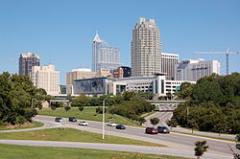
Raleigh (pronounced /ËnrÉeËali/, RAH-lee) is the capital and the second largest city in the state of North Carolina as well as the seat of Wake County. Raleigh is known as the "City of Oaks" for its many oak trees. According to the U.S. Census Bureau, the city's 2011 estimated population was 416,468, over an area of 142.8 square miles (370 km2), making Raleigh currently the 42nd largest city in the United States. It is also one of the fastest-growing cities in the country. The city of Raleigh is named after Sir Walter Raleigh, who established the lost Roanoke Colony on Roanoke Island in present-day Dare County, North Carolina.
Raleigh, Durham, and Chapel Hill make up the three primary cities of the Research Triangle metropolitan region. The regional nickname of "The Triangle" originated after the 1959 creation of the Research Triangle Park, primarily located in Durham County, four miles from downtown Durham. RTP is bordered on three sides by the city of Durham and is roughly midway between the cities of Raleigh and Chapel Hill, and three major research universities of NC State University, Duke University, and UNC-Chapel Hill.
Effective June 6, 2003 the U.S. Office of Management and Budget redefined the Federal Statistical Areas and dismantled what had been for decades the Raleigh-Durham-Chapel Hill, MSA and split them into two separate MSAs, even though the region still functions as a single metropolitan area. This resulted in the formation of the Raleigh-Cary, NC MSA and the Durham-Chapel Hill, NC MSA.
The Research Triangle region encompasses the U.S. Census Bureau's Combined Statistical Area (CSA) of Raleigh-Durham-Cary in the central Piedmont region of North Carolina. As of 2011 Census Estimate the population of the Raleigh-Durham-Cary CSA was 1,795,750. The Raleigh-Cary Metropolitan Statistical Area (MSA) as of 2011 Census Estimate was 1,163,750.
Most of Raleigh is located within Wake County, with a very small portion extending into Durham County. The towns of Cary, Morrisville, Garner, Clayton, Wake Forest, Apex, Holly Springs, Fuquay-Varina, Knightdale, Wendell, Zebulon, and Rolesville are some of Raleigh's primary nearby suburbs and satellite towns.
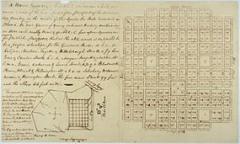
In December 1770, Joel Lane successfully petitioned the North Carolina General Assembly to create a new county. On January 5, 1771, the bill creating Wake County was passed in the General Assembly, resulting in the formation of Wake County. The county was formed from portions of Cumberland, Orange, and Johnston counties. The county gets its name from Margaret Wake Tryon, the wife of Governor William Tryon. The first county seat was Bloomsbury.
New Bern, a port town 35 miles from the Atlantic Ocean, was the largest city and the capital of North Carolina during the American Revolution. When the British Army laid siege to the city, governing from that location on the wide Neuse River became infeasible.
Raleigh was chosen as the site of the new capital in 1788, as its central location protected it from attacks from the coast. Officially established in 1792 as both county seat and state capital, the city was named for Sir Walter Raleigh, sponsor of Roanoke, the "lost colony" on Roanoke Island.
The city's location was chosen, in part, for being within 11 miles (16 km) of Isaac Hunter's Tavern, a popular tavern frequented by the state legislators. No known city or town existed previously on the chosen city site. Raleigh is one of the few cities in the United States that was planned and built specifically to serve as a state capital. Its original boundaries were formed by the downtown streets of North, East, West and South streets. It was planned to be laid out in an axial fashion, with four public squares and one central square.
The North Carolina General Assembly first met in Raleigh in December 1794, and quickly granted the city a charter, with a board of seven appointed commissioners (elected by the city after 1803) and an "Intendant of Police" (which would eventually become the office of Mayor) to govern it. In 1799, the N.C. Minerva and Raleigh Advertiser became the first newspaper published in Raleigh. John Haywood was the first Intendant of Police.
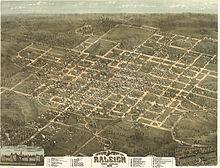
In 1808 Andrew Johnson, the nation aos seventeenth President, was born at Casso aos Inn in Raleigh. The city's first water supply network was completed in 1818, although due to system failures the project was abandoned. 1819 saw the arrival of Raleigh's first volunteer fire company, followed in 1821 by a full-time fire company.
In 1831, a fire destroyed the State Capitol. Reconstruction began two years later with quarried granite being delivered by the first railroad in the state. Raleigh celebrated the completions of the new Capitol and new Raleigh & Gaston Railroad Company in 1840.
In 1853, the first State Fair was held near Raleigh. The first institution of higher learning in Raleigh, Peace College, was established in 1857. Raleigh's Historic Oakwood contains many houses from the 19th century that are still in good condition.
After the Civil War began, Governor Zebulon Baird Vance ordered the construction of breastworks around the city as protection from Union troops. During General Sherman's Carolinas Campaign, Raleigh was captured by Union cavalry under the command of General Hugh Judson Kilpatrick on April 13, 1865. As the Confederate cavalry retreated west, the Union soldiers followed, leading to the nearby Battle of Morrisville. The city was spared significant destruction during the War, but due to the economic problems of the post-war period and Reconstruction, with a state economy based on agriculture, it grew little over the next several decades.
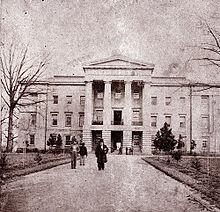
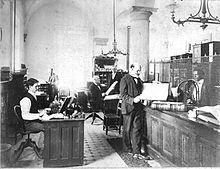
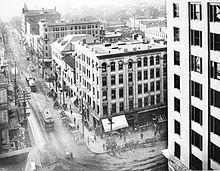
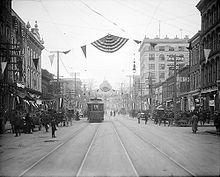
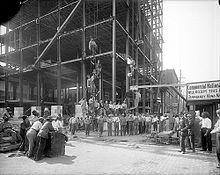
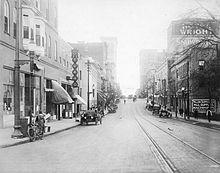
After the Civil War ended in 1865, African Americans were emancipated. The Reconstruction legislature established public education for blacks and whites. The men, like whites, were admitted to the franchise of voting. Blacks had already been organizing in churches and other community-based organizations. Freedmen were often led by free blacks who had become educated before the war. With the help of the Freedmen's Bureau, many freedmen migrated from rural areas to Raleigh. It had a free black community and many freedmen wanted to get out from under white supervision in the rural areas.
Shaw University, the South's first African-American college, began classes in 1865 and was chartered in 1875. Its Estey Hall was the first building constructed for the higher education of black women, and Leonard Medical Center was the first four-year medical school in the country for African Americans.
In 1867, Episcopal clergy founded St. Augustine's College for the education of freedmen. The biracial Reconstruction legislature created new welfare institutions: in 1869, it approved the nation aos first school for blind and deaf blacks, to be located in Raleigh. And in 1874, a Federal Building was constructed in Raleigh, the first federal government project in the South following the Civil War.
In 1880, the newspapers News and Observer combined to form The News & Observer. It remains Raleigh's primary daily newspaper. The North Carolina College of Agriculture and Mechanic Arts, now known as North Carolina State University, was founded as a land-grant college in 1887. The city's Rex Hospital opened in 1889 and included the state's first nursing school. The Baptist Women's College, now known as Meredith College, opened in 1891, and in 1898, The Academy of Music, a private music conservatory, was established.
In the late nineteenth century, two black Congressmen were elected from North Carolina's 2nd district, the last in 1898. George Henry White sought to promote civil rights for blacks and to challenge efforts by white Democrats to reduce black voting by new discriminatory laws. They were unsuccessful. In 1900, the state legislature passed a new constitution, with voter registration rules that disfranchised most blacks and many poor whites. The state succeeded in reducing black voting to zero by 1908. Loss of the ability to vote disqualified black men (and later women) from sitting on juries and serving in any office, local, state or federal. The rising black middle-class in Raleigh and other areas was politically silenced and shut out of local governance, and the Republican Party was no longer competitive. It was not until after federal civil rights legislation was passed in the mid-1960s that the majority of blacks in North Carolina would again be able to vote, sit on juries and serve in local offices. No African American was elected to Congress until 1992.
In 1912, Bloomsbury Park opened, featuring a popular carousel ride. Relocated to Pullen Park, the carousel is still operating.
From 1914-1917, an influenza epidemic killed 288 Raleigh citizens.
In 1922, WLAC signed on as the city's first radio station, but lasted only two years. WFBQ signed on in 1924 and became WPTF in 1927. It is now Raleigh's oldest continuous radio broadcaster.
On December 12, 1924, The Roman Catholic Diocese of Raleigh was officially established by the Vatican and the Sacred Heart Cathedral became the official seat of the diocese.
The city's first airport, Curtiss-Wright Flying Field opened in 1929. That same year, the stock market crash resulted in six Raleigh banks closing.
During the difficult 1930s of the Great Depression, government at all levels was integral to creating jobs. The city provided recreational and educational programs, and hired people for public works projects. In 1932, Raleigh Memorial Auditorium was dedicated. The North Carolina Symphony, founded the same year, performed in its new home. From 1934-1937, the federal Civilian Conservation Corps constructed the area now known as William B. Umstead State Park. In 1939, the State General Assembly chartered the Raleigh-Durham Aeronautical Authority to build a larger airport between Raleigh and Durham, with the first flight occurring in 1943.
In 1947, Raleigh citizens adopted a council-manager form of government, the current form.
The Dorton Arena, a 7,610-seat multi-purpose arena designed by Matthew Nowicki, was opened in 1952 on the grounds of the North Carolina State Fair. It was listed in the National Register of Historic Places in 1973.
Raleigh experienced significant damage from Hurricane Hazel in 1954.
In 1956, WRAL-TV became the first local television station.
With the opening of the Research Triangle Park in 1959, Raleigh began to experience a population increase, resulting in a total city population of 100,000 by 1960. In 1960, the Census Bureau reported Raleigh's population as 76.4% white and 23.4% black.
Following passage of the federal Voting Rights Act, one of the main achievements of the African-American Civil Rights Movement (1955-1968) and the Lyndon B. Johnson presidency, political participation and voting by African Americans in Raleigh increased rapidly. In 1967, Clarence E. Lightner was elected to the City Council, and in 1973 became Raleigh's first African-American mayor.
In 1976, the Raleigh City and Wake County schools merged to become the Wake County Public School System, now the largest school system in the state and 19th largest in the country.
During the 1970s and 1980s, the I-440 beltline was constructed, easing traffic congestion and providing access to most major city roads.
The first Raleigh Convention Center (replaced in 2008) and Fayetteville Street Mall were both opened in 1977. Fayetteville Street was turned into a pedestrian-only street in an effort to help the then-ailing downtown area, but the plan was flawed and business declined for years to come. Fayetteville Street was reopened in 2007 as the main thoroughfare of Raleigh's downtown.
The 1988 Raleigh tornado outbreak of November 28, 1988, was the most destructive of the seven tornadoes reported in Northeastern North Carolina and southeastern Virginia between 1:00 AM and 5:45 AM. The Raleigh tornado produced over $77 million in F4 damage, along with four fatalities (two in the city of Raleigh, and two in Nash County) and 154 injuries. The damage path from the storm was measured at 84 miles (135 km) long, and .5 miles (0.8 km) wide at times.
In 1991, two large skyscrapers in Raleigh were completed, First Union Capitol Center and Two Hannover Square, along with the popular Walnut Creek Amphitheatre in Southeast Raleigh.
In 1996, the Olympic Flame passed through Raleigh while on its way to the 1996 Summer Olympics in Atlanta, Georgia. Also in 1996, Hurricane Fran struck the area, causing massive flooding and extensive structural damage.
In 1997, the National Hockey League's Hartford Whalers announced their intention to move to Raleigh as the Carolina Hurricanes, becoming the City's first major league professional sports franchise.
In 1999, the Raleigh Entertainment and Sports Arena (later renamed the RBC Center and now called PNC Arena), opened to provide a home for the Hurricanes and the NC State Wolfpack men's basketball team, as well as an up-to-date major concert venue.
In the first decade of the 21st century, Raleigh was featured prominently in a number of "Top 10 Lists," including those by Forbes, MSNBC and Money Magazine, due to its quality of life and business climate.
In 2001, the Raleigh Memorial Auditorium complex was expanded with the addition of the Progress Energy Center for the Performing Arts, Meymandi Concert Hall, Fletcher Opera Theater, Kennedy Theatre, Betty Ray McCain Gallery and Lichtin Plaza.
Fayetteville Street reopened to vehicular traffic in 2006. A variety of downtown building projects began around this time including the 34-story RBC Bank Tower, multiple condominium projects and several new restaurants. Additional skyscrapers are in the proposal/planning phase.
In 2006, the city's NHL franchise, the Carolina Hurricanes won the Stanley Cup, North Carolina's first and only professional sports championship.
With the opening of parts of I-540 from 2005 ae2007, a new 70-mile (110 km) loop around Wake County, traffic congestion eased somewhat in the North Raleigh area. Completion of the entire loop is expected to take another 15 years.
Plans are currently underway to build a combination of high-speed rail, light rail, and commuter rail lines to and from the city's core.
In 2008, the city's Fayetteville Street Historic District joined the National Register of Historic Places.
In September 2010, Raleigh hosted the inaugural Hopscotch Music Festival.
In January 2011, Raleigh hosted the National Hockey League All-Star Game.
In April 2011, a devastating EF-3 tornado hit Raleigh, and many other tornadoes touched down in the state (ultimately the largest, but not the strongest (1984 Carolinas tornado outbreak) outbreak to ever hit the state), killing 24 people. The tornado tracked northeast through parts of Downtown, East Central Raleigh and Northeast Raleigh and produced $115 million dollars in damages in Wake County. There were 4 fatalities in the city.
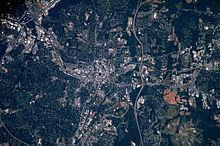
According to the United States Census Bureau, Raleigh occupies a total area of 115.6 square miles (299 km2), of which 114.6 square miles (297 km2) is dry land and 1.0 square mile (2.6 km2) (0.84%) is covered by water.
Raleigh is located in the northeast central region of North Carolina, where the North American Piedmont and Atlantic Coastal Plain regions meet. This area is known as the "fall line" because it marks the elevation inland at which waterfalls begin to appear in creeks and rivers. As a result, most of Raleigh features gently rolling hills that slope eastward toward the state's flat coastal plain. Its central Piedmont location situates Raleigh about two hours west of Atlantic Beach, North Carolina, by car and four hours east of the Great Smoky Mountains of the Appalachian range. The city is 145 miles (233 km) south of Richmond, Virginia; 232 miles (373 km) south of Washington, D.C.; and 143 miles (230 km) northeast of Charlotte, North Carolina.
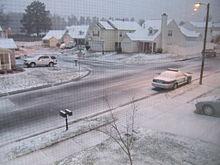
Raleigh experiences a humid subtropical climate, with generally moderate temperatures during spring and autumn. Summers are typically hot. Winters are mild and wet with highs generally in the range of 47 ae53 °F (8 ae12 °C) with lows around or just below freezing, although an occasional 60 °F (16 °C) or warmer winter day is not uncommon. Lows may also fall into the 15-20 °F (-9 to -7 °C) range, but rarely any further. The record low temperature is na9 °F ( na23 °C), set in January 1985. Spring and autumn features warm days and cool nights. Summer daytime highs average in the upper 80s to low 90s °F (31-34 °C) with warm and humid nights in the upper 60s (19-21 °C). Temperatures can reach 100 °F (38 °C). The record high temperature is 105 °F (41 °C) set six times, most recently on July 8, 2012. The region's rainiest months are January and March with the driest months being April and November.
Raleigh receives an average of 6.0 inches (15.2 cm) of snow in winter. Freezing rain and sleet also occur most winters, and occasionally the area experiences a major damaging ice storm. On January 24 ae25, 2000, Raleigh received its greatest snowfall from a single storm - 20.3 inches (52 cm) - during the Winter Storm of January 2000. Storms of this magnitude are generally the result of cold air damming that affects the city due to its proximity to the Appalachian Mountains.
The region also experiences occasional periods of drought, during which the city sometimes has restricted water use by residents. During the late summer and early fall, Raleigh can experience hurricanes. In 1996, Hurricane Fran caused severe damage in the Raleigh area, mostly from falling trees. The most recent hurricane to have a considerable effect on the area was Isabel in 2003.

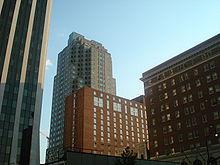
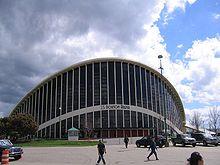
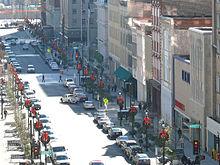
Raleigh is divided into several major geographic areas, each of which use a Raleigh address and a ZIP code that begins with the digits 276. PNC Plaza, formerly known as RBC Plaza, is the largest and tallest skyscraper in the city of Raleigh. The tower rises to a height of 538 feet (164 m), with a floor count of 34.
Downtown/Old Raleigh ("Inside the Beltline" or ITB) is home to historic neighborhoods and buildings such as the Sir Walter Raleigh Hotel built in the early 20th century, the restored City Market, the Fayetteville Street downtown business district, the Cameron Village midtown business district, which includes the PNC Plaza and Wells Fargo Capitol Center buildings, as well as the North Carolina Museum of History, North Carolina Museum of Natural Sciences, North Carolina State Capitol, Peace College, the Raleigh City Museum, Raleigh Convention Center, Shaw University, and St. Augustine's College. The neighborhoods in Old Raleigh include Cameron Park, Boylan Heights, Country Club Hills, Coley Forest, Five Points, Budleigh, Glenwood-Brooklyn, Hayes Barton Historic District, Moore Square, Mordecai, Rosengarten Park, Belvidere Park, Woodcrest, and Historic Oakwood.
Midtown Raleigh, is a residential and commercial area just North of the I-440 Beltline and is part of North Raleigh. It is roughly framed by Glenwood/Creedmoor Road to the West, Wake Forest Road to the East, and Millbrook Road to the North. It includes shopping centers such as North Hills and Crabtree Valley Mall. It also includes North Hills Park and part of the Raleigh Greenway System. The term was coined by the Greater Raleigh Chamber of Commerce, developer John Kane and planning director Mitchell Silver. The News & Observer newspaper started using the term for marketing purposes only.
Uptown Raleigh, is a residential and commercial area at the intersection of Glenwood and Creedmoor adjacent to the Beltline. Crabtree Valley Mall is the anchor of the area. This label is not used by anyone. The Soleil Center, what was to be the second tallest building in Raleigh at 480, was planned to be built here, but due to the financial Crisis of 2008 lost funding and now is stalled. This enclave is still considered to be part of North Raleigh, because in the past it was known as the outskirts of Raleigh, a very rural country land. The 27612 zip code is the most popular zip code in this area. The main roads are Millbrook Road and North Hills Drive.
East Raleigh is situated roughly from Capital Boulevard near the I-440 beltline to New Hope Road. Most of East Raleigh's development is along primary corridors such as U.S. 1 (Capital Boulevard), New Bern Avenue, Poole Road, Buffaloe Road, and New Hope Road. Neighborhoods in East Raleigh include New Hope, and Wilder's Grove. The area is bordered to the east by the town of Knightdale.
West Raleigh lies along Hillsborough Street and Western Boulevard. The area is bordered to the west by suburban Cary. It is home to North Carolina State University, Meredith College, Pullen Park, Pullen Memorial Baptist Church, Cameron Village, Lake Johnson, the North Carolina Museum of Art and historic Saint Mary's School. Primary thoroughfares serving West Raleigh, in addition to Hillsborough Street, are Avent Ferry Road, Blue Ridge Road, and Western Boulevard. West Raleigh is also home to the nation's smallest Roman Catholic cathedral, Sacred Heart Cathedral. The PNC Arena is also located here adjacent to the North Carolina State Fairgrounds. These are located approximately 2 miles from Rex Hospital.
North Raleigh is an expansive, diverse, and fast-growing suburban area of the city that is home to established neighborhoods to the south along with many newly built subdivisions and along its northern fringes. The area generally falls North of Millbrook Road. It is primarily suburban with large shopping areas. Primary neighborhoods and subdivisions in North Raleigh include Bedford, Bent Tree, Brentwood, Brier Creek, Brookhaven, Black Horse Run, Crossgate, Crosswinds, Falls River, Hidden Valley, Lake Park, North Haven, North Ridge, Oakcroft, Shannon Woods, Six Forks Station, Springdale, Stonebridge, Stone Creek, Stonehenge, Valley Estates, Wakefield, Windsor Forest, and Wood Valley. The area is served by a number of primary transportation corridors including Glenwood Avenue (U.S. Route 70), Interstate 540, Wake Forest Road, Millbrook Road, Lynn Road, Six Forks Road, Spring Forest Road, Creedmoor Road, Leesville Road, Strickland Road, and North Hills Drive.
Northeast Raleigh is a subsection of North Raleigh. Northeast Raleigh is anchored by Capital Boulevard and the Mini City area. The Triangle Town Center mall is the closest mall, and the area is served by CAT bus routes #1, #23c, #24c, #25c, and #26c.
South Raleigh is located along U.S. 401 South toward Fuquay-Varina and along US 70 into suburban Garner. This area is the least developed and least dense area of Raleigh (much of the area lies within the Swift Creek watershed district, where development regulations limit housing densities and construction). The area is bordered to the west by Cary, to the east by Garner, and to the southwest by Holly Springs. Neighborhoods in South Raleigh include Lake Wheeler, Swift Creek, Riverbrooke, and Enchanted Oaks.
Southeast Raleigh is bounded by downtown on the west, Garner on the southwest, and rural Wake County to the southeast. The area includes areas along Rock Quarry Road, Martin Luther King Jr. Boulevard, and New Bern Avenue. This area is very diverse, with new suburban developments to poor inner-city neighborhoods. Many of the older neighborhoods are historically African American and date back to the end of the Civil War. Primary neighborhoods include Chavis Heights, Raleigh Country Club, Southgate, Kingwood Forest and Biltmore Hills. Time Warner Cable Music Pavilion (formerly Alltel Pavilion and Walnut Creek Amphitheatre) is one of the region's major outdoor concert venues and is located on Rock Quarry Road. Shaw University, the oldest HBCU in the South, is located between Martin Luther King Jr. Boulevard and South Street in this part of the city.
According to the 2010 Census, the racial composition of the city was:
As of the 2000 United States census, there were 276,093 persons (July 2008 estimate was 380,173) and 61,371 families residing in Raleigh. The population density was 2,409.2 people per square mile (930.2/km ²). There were 120,699 housing units at an average density of 1,053.2 per square mile (406.7/km ²). The racial composition of the city was: 63.31% White, 27.80% Black or African American, 7.01% Hispanic or Latino American, 3.38% Asian American, 0.36% Native American, 0.04% Native Hawaiian or Other Pacific Islander, 3.24% some other race, and 1.88% two or more races.
There were 112,608 households in the city in 2000, of which 26.5% included children below the age of 18, 39.5% were composed of married couples living together, 11.4% reported a female householder with no husband present, and 45.5% classified themselves as nonfamily. In addition, 33.1% of all households were composed of individuals living alone, of which 6.2% was someone 65 years of age or older. The average household size in Raleigh was 2.30 persons, and the average family size was 2.97 persons.
Raleigh's population in 2000 was evenly distributed with 20.9% below the age of 18, 15.9% aged 18 to 24, 36.6% from 25 to 44, and 18.4% from 45 to 64. An estimated 8.3% of the population was 65 years of age or older, and the median age was 31 years. For every 100 females, there were 98.0 males; for every 100 females aged 18 or older, there were 96.6 males aged 18 or older.
The median household income in the city was $46,612 in 2000, and the median family income was $60,003. Males earned a median income of $39,248, versus $30,656 for females. The median per capita income for the city was $25,113, and an estimated 11.5% of the population and 7.1% of families were living below the poverty line. Of the total population, 18.8% of those below the age of 18, and 9.3% of those 65 and older, were living below the poverty line.
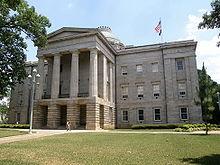
Historically, Raleigh voters have tended to elect conservative Democrats in local, state, and national elections, a holdover from their one-party system of the late 19th century. Today, they tend to elect progressive Democrats.
Raleigh operates under a council-manager government. Raleigh City Council consists of eight members; all seats, including the Mayor's, are open for election every two years. Five of the council seats are district representatives and two seats are citywide representatives elected at-large.
According to the Federal Bureau of Investigation's Uniform Crime Reports, in 2010 the Raleigh Police Department and other agencies in the city reported 1,740 incidents of violent crime and 12,995 incidents of property crime. Of the violent crimes reported, 14 were murders, 99 were forcible rapes and 643 were robberies. Aggravated assault accounted for 984 of the total violent crimes. Property crimes included burglaries which accounted for 3,021, larcenies for 9,104 and arson for 63 of the total number of incidents. Motor vehicle theft accounted for 870 incidents out of the total.
The Raleigh Fire Department provides fire protection throughout the city.
Raleigh's industrial base includes banking/financial services; electrical, medical, electronic and telecommunications equipment; clothing and apparel; food processing; paper products; and pharmaceuticals. Raleigh is part of North Carolina's Research Triangle, one of the country's largest and most successful research parks and a major center in the United States for high-tech and biotech research, as well as advanced textile development. The city is a major retail shipping point for eastern North Carolina and a wholesale distributing point for the grocery industry.
Companies based in Raleigh include BB&T Insurance Services, Capitol Broadcasting Company, Carquest, First Citizens BancShares, Golden Corral, Martin Marietta Materials, and Red Hat.
According to Raleigh's 2011 Comprehensive Annual Financial Report, the top employers in the city are:
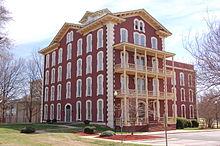
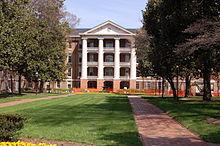
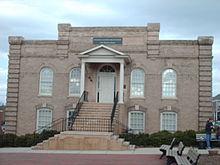
As of 2011, Time ranked Raleigh, NC as the third most educated city in the US based on the percentage of residents who held college degrees. This statistic can most likely be credited to the presence of universities in and around Raleigh, as well as the presence of Research Triangle Park to the Northwest.
Public schools in Raleigh are operated by the Wake County Public School System. Observers have praised the Wake County Public School System for its innovative efforts to maintain a socially, economically and racial balanced system by using income as a prime factor in assigning students to schools. Raleigh is home to three magnet high schools; William G. Enloe High School, Southeast Raleigh High School, and Millbrook High School.
The State of North Carolina provides for a legislated number of charter schools. These schools are administered independently of the Wake County Public School System. Raleigh is currently home to eleven such charter schools:
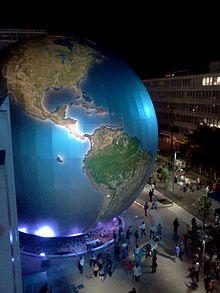
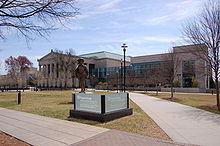
The Time Warner Cable Music Pavilion at Walnut Creek hosts major international touring acts. The Progress Energy Center for the Performing Arts complex houses the Raleigh Memorial Auditorium, the Fletcher Opera Theater, the Kennedy Theatre, and the Meymandi Concert Hall. During the North Carolina State Fair, Dorton Arena hosts headline acts. In 2008, a new theatre space, the Meymandi Theatre at the Murphey School, was opened in the restored auditorium of the historic Murphey School. Theater performances are also offered at the Raleigh Little Theatre, Long View Center, Ira David Wood III Pullen Park Theatre, and Stewart and Thompson Theaters at North Carolina State University.
Raleigh is home to several professional arts organizations, including the North Carolina Symphony, the Opera Company of North Carolina, Theatre In The Park, Burning Coal Theatre Company, the North Carolina Theatre, Broadway Series South and the Carolina Ballet. The numerous local colleges and universities significantly add to the options available for viewing live performances.
North Carolina Museum of Art, occupying a large suburban campus on Blue Ridge Road near the North Carolina State Fairgrounds, maintains one of the premier public art collections located between Washington, D.C., and Atlanta. In addition to its extensive collections of American Art, European Art and ancient art, the museum recently has hosted major exhibitions featuring Auguste Rodin (in 2000) and Claude Monet (in 2006-07), each attracting more than 200,000 visitors. Unlike most prominent public museums, the North Carolina Museum of Art acquired a large number of the works in its permanent collection through purchases with public funds. The museum's outdoor park is one of the largest such art parks in the country. The museum facility underwent a major expansion which greatly expanded the exhibit space that was completed in 2010. The 127,000 sf new expansion is designed by NYC architect Thomas Phifer and Partners.
Raleigh's downtown is also home to many local art galleries such as Art Space and Visual Art Exchange in City Market and Bee Hive Studios on Harget Street. CAM Raleigh is a downtown modern art museum that serves to promote new artists and does not house a permanent collection. CAM Raleigh was designed by the award-winning architectural firm Brooks+Scarpa of Los Angeles, CA.
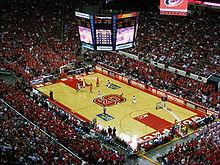
The National Hockey League's Carolina Hurricanes franchise moved to Raleigh in 1997 from Hartford, Connecticut (where it was known as the Hartford Whalers). The team played its first two seasons more than 60 miles away in Greensboro while its home arena, Raleigh Entertainment and Sports Arena (later RBC Center and now PNC Arena), was under construction. The Hurricanes are the only major league (NFL, NHL, NBA, MLB) professional sports team in North Carolina to have won a championship, winning the Stanley Cup in 2006, over the Edmonton Oilers. The city played host to the 2011 NHL All-Star Game.
In addition to the Hurricanes, the Carolina RailHawks FC of the North American Soccer League play in suburban Cary to the west; the Carolina Mudcats, an AA minor-league baseball team, play in the city's eastern suburbs; and the Durham Bulls, the AAA minor-league baseball team made internationally famous by the movie Bull Durham, play in the neighboring city of Durham.
Several other professional sports leagues have had former franchises (now defunct) in Raleigh, including the Arena Football League; the World League of American Football; the Raleigh Cougars of the United States Basketball League; and most recently, the Carolina Courage of the Women's United Soccer Association (in suburban Cary), which won that league's championship Founders Cup in 2002.
The Research Triangle region has hosted the Professional Golfers' Association (PGA) Nationwide Tour Rex Hospital Open since 1994, with the current location of play at Raleigh's Wakefield Plantation.
North Carolina State University is located in southwest Raleigh where the Wolfpack competes nationally in 24 intercollegiate varsity sports as an original member of the Atlantic Coast Conference. The university's football team plays in Carter-Finley Stadium, the third largest football stadium in North Carolina, while the men's basketball team shares the PNC Arena with the Carolina Hurricanes hockey club.
The North Carolina Tigers compete as an Australian Rules football club in the United States Australian Football League, in the Eastern Australian Football League.
Raleigh is also home to the Carolina Rollergirls, an all-women flat-track roller derby team that is a competing member of the Women's Flat Track Derby Association. The Carolina Rollergirls compete at Dorton Arena at the North Carolina State Fairgrounds.
Raleigh is also home to one of the Cheer Extreme All Stars gyms. In 2009 and again in 2010, Cheer Extreme Raleigh's Small Senior Level 5 Team were silver medalists at the Cheerleading Worlds Competition in Orlando, Florida, and in 2012 they received the bronze medal.
The Raleigh Parks and Recreation Department offers a wide variety of leisure opportunities at more than 150 sites throughout the city, which include: 8,100 acres (33 km2) of park land, 78 miles (126 km) of greenway, 22 staffed community centers, a BMX championship-caliber race track, 112 tennis courts among 25 locations, 5 public lakes, and 8 public aquatic facilities.
The J. C. Raulston Arboretum, an 8 acre (32,000 m ²) arboretum and botanical garden in west Raleigh administered by North Carolina State University, maintains a year-round collection that is open daily to the public without charge.
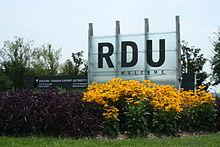
(IATA: RDU, ICAO: KRDU, FAA LID: RDU)
Raleigh-Durham International Airport, the region's primary airport and the second-largest in North Carolina, located northwest of downtown Raleigh via Interstate-40 between Raleigh and Durham, serves the city and greater Research Triangle metropolitan region, as well as much of eastern North Carolina. The airport offers service to more than 35 domestic and international destinations and serves approximately 10 million passengers a year. The airport also offers facilities for cargo and general aviation. The airport authority tripled the size of its Terminal 2 (formerly Terminal C) in January 2011.
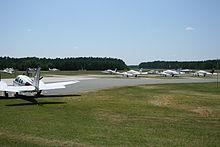
In addition to RDU, several smaller publicly-owned general-aviation airports also operate in the metropolitan region:
Several licensed private general-aviation airports operate in Raleigh's immediate suburban areas:
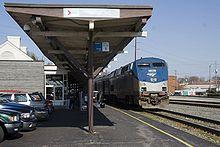
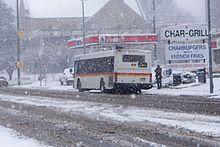
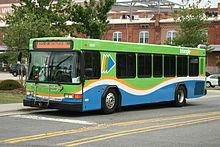
Raleigh's train station is one of Amtrak's busiest stops in the Southern U.S. The station is served by four passenger trains daily: the Silver Star, twice-daily Piedmont service, and the Carolinian. Daily service is offered between Raleigh and:
Public transportation in and around Raleigh is provided by Capital Area Transit (CAT), which operates 43 fixed bus routes, including the R-Line and the Wake-Forest Loop. Although there are 43 routes, some routes are designed to cover multiple other routes at times when they are not served. Depending on the time of the day, and the day of the week, the number of routes operating is between 5 and 29.
Raleigh is also served by Triangle Transit (known formerly as the Triangle Transit Authority, or TTA). Triangle Transit offers scheduled, fixed-route regional and commuter bus service between Raleigh and the region's other principal cities of Durham, Cary and Chapel Hill, as well as to and from the Raleigh-Durham International Airport, Research Triangle Park and several of the region's larger suburban communities. Triangle Transit also coordinates an extensive vanpool and rideshare program that serves the region's larger employers and commute destinations.
North Carolina State University also maintains its own transit system, the Wolfline, that provides zero-fare bus service to the general public along multiple routes serving the university's campuses in southwest Raleigh.
Government agencies throughout the Raleigh-Durham metropolitan area have struggled with determining the best means of providing fixed-rail transit service for the region.
From 1995 the cornerstone of Triangle Transit's long-term plan was a 28-mile rail corridor from northeast Raleigh, through downtown Raleigh, Cary, and Research Triangle Park, to Durham using DMU technology. There were proposals to extend this corridor 7 miles to Chapel Hill with light rail technology. However, in 2006 Triangle Transit deferred implementation indefinitely when the Federal Transit Administration declined to fund the program due to low ridership projections.
The region's two metropolitan planning organizations appointed a group of local citizens in 2007 to reexamine options for future transit development in light of Triangle Transit's problems. The Special Transit Advisory Commission (STAC) retained many of the provisions of Triangle Transit's original plan, but recommended adding new bus services and raising additional revenues by adding a new local half-cent sales tax to fund the project.
There are several newspapers and periodicals serving Raleigh:
Raleigh is part of the Raleigh-Durham-Fayetteville Designated Market Area, the 24th largest broadcast television market in the United States. The following stations are licensed to Raleigh and/or have significant operations and viewers in the city:
Raleigh is home to the Research Triangle Region bureau of the regional cable news channel News 14 Carolina.
Raleigh has several sister cities:
Source:

Word Count: 6845






